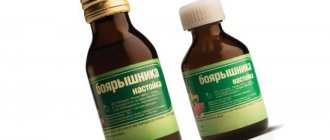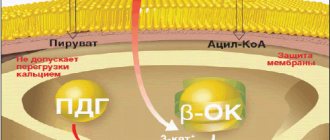General information
The human body is designed in such a way that as we age, all organs gradually wear out.
And in order for each organ to serve “without breakdowns” for as long as possible, it is important to ensure high-quality disease prevention. If we are talking about the most important organ - the heart, then prevention methods consist of giving up alcohol consumption and smoking, losing body weight, and normalizing lipid metabolism.
However, in addition to the points described, the use of potassium and magnesium supplements will help prevent cardiovascular diseases and their complications. Why such medications are needed for the body, in what cases potassium and magnesium preparations are used, and why you need to consume foods containing magnesium and potassium will be discussed in the article below.
Indications for use
The use of microelements is advisable when their deficiency is established and there is a risk of developing heart failure. The following can lead to a decrease in minerals: excessive salt intake, use of diuretics, vomiting or diarrhea, and a strict diet.
Some drugs can be prescribed in combination to eliminate chronic diseases (myocardial infarction, heart failure), arrhythmia. To get the best results from therapy, it is recommended to adhere to a diet based on foods rich in these minerals.
What are the benefits of magnesium and potassium?
Potassium
Taking potassium supplements is very important for the prevention of heart and vascular diseases. After all, potassium in the body promotes the functioning of the conduction system of the heart and ensures the regulation of blood pressure . It is important to take medications containing potassium not only for the heart. This mineral determines the transmission of excitation from nerve cells to muscles and is responsible for maintaining water and electrolyte balance. By activating enzymes , potassium participates in the regulation of protein and carbohydrate metabolism. It also takes part in the synthesis of proteins and the conversion of glucose into glycogen .
Potassium preparations in tablets help to activate urine flow.
Potassium is contained in tablets, the price of which is relatively low. However, some complex drugs have a higher cost.
You can replenish your reserves of this microelement by consuming foods high in it. A large amount of potassium is found in dried fruits (raisins and dried apricots), leafy greens, legumes, watermelons, melons, kiwi, etc. Slightly less of this trace element is found in potatoes, milk, and beef.
The adult body needs from 2 to 5 g of potassium per day from food (this depends on physical activity). However, it is important to know that approximately 90% of potassium is absorbed from food. This is provided that the absorption process occurs normally and there is no diarrhea or vomiting.
Magnesium
Magnesium in the body promotes the breakdown of glucose. It is involved in various enzymatic reactions that help increase cell stability and renewal. Due to the synthesis of B vitamins, magnesium improves the process of neuromuscular transmission. Therefore, magnesium preparations are indicated for various diseases. In particular, preparations with magnesium are effective for leg cramps.
If you take medications containing potassium, magnesium and calcium, vascular tone improves. Also, magnesium, when interacting with potassium, takes part in muscle contraction.
The use of magnesium is also advisable from the point of view that it activates the absorption of potassium and regulates the content of this trace element in the blood. The optimal ratio of potassium and magnesium in food is 2 to 1. This allows you to maintain the density of bone tissue and protect teeth from destruction.
Preparations containing magnesium are also taken “for the heart,” since this microelement stabilizes cell membranes, allowing potassium and chlorine ions to penetrate through them. This allows you to lower blood pressure and stabilize the heart rhythm.
The price of such drugs may vary. But it is not always necessary to take magnesium-containing medications. After all, a large amount of this microelement is found in food products - legumes, cereals, cabbage, seafood, fish, nuts, etc.
Magnesium is easily absorbed from consumed dairy products, although they contain relatively little of it. A person should receive 400 mg of this microelement per day.
Benefits and harm to the body
Potassium is closely related to elements such as Na and Mg. In combination with the first, it stabilizes the water balance and normalizes the heart rhythm. The optimal potassium content ensures the desired magnesium concentration and its physiological functions.
The mineral is important for the process of transmitting nerve impulses. In normal quantities, it promotes brain function by improving oxygen supply.
Potassium helps the body cope with many allergic diseases. It regulates the content of acids, alkalis, salts, thereby reducing swelling.
An excess of this substance affects the body no less harmfully than its deficiency. The excretory function is impaired, the musculoskeletal and cardiovascular systems suffer. The most severe consequence of deficiency is paralysis of the legs and arms.
Symptoms of Potassium Deficiency
A lack of potassium can be the result of an unbalanced diet, excessive vomiting, excessive sweating, taking diuretics, or prolonged stress.
The main manifestations by which one can suspect a deficiency of an element in the body:
- Fatigue, general weakness, apathy. You may feel muscle soreness. A lack of potassium interferes with the restoration of energy at the cellular level, resulting in chronic fatigue. The progression of deficiency is indicated by spasms, numbness, tingling sensation, and severe weakness.
- Heart rhythm disturbances. The heartbeat becomes erratic and unstable for no apparent reason. Some people experience a slow heart rate, which leads to dizziness.
- Fluctuations in blood pressure. This can be affected by both excess potassium and deficiency of the substance. Blood pressure can rise and fall.
- Cramps. Muscle contraction occurs due to the potassium content in it. If there is a lack of substance, the muscles are not able to relax normally, which causes cramps.
Symptoms of potassium deficiency.
It is also necessary to pay attention to such signs as nausea, swelling, drowsiness, difficulty breathing, decreased urine output, and allergic manifestations.
The critically low value of potassium in the body is less than 2 mmol/l.
When there is excess potassium
Hyperkalemia is an increased level of potassium in the blood. The diagnosis is made when the level is above 5.0-5.3 mmol/l. The causes of this phenomenon are considered to be renal failure, severe disorders of the renal tissue, and reduced secretion of aldosterone.
At first, excess potassium is difficult to suspect. Hyperkalemia is often discovered accidentally during testing for a disease. For a long time, the only manifestation may be a slight disturbance in heart rhythm.
As hyperkalemia progresses, the following symptoms may occur:
- vomit;
- clouding of consciousness;
- convulsive twitching;
- stomach cramps;
- arrhythmia;
- rare urge to urinate;
- tingling sensation, numbness of the limbs.
What does excess magnesium and potassium lead to?
It is very important that a person takes magnesium- and potassium-containing drugs strictly according to indications and in the dosage prescribed by the doctor. You cannot choose a medicine by reading information about it or listening to the recommendations of a pharmacist. The most important thing is to never listen to harmful advice that large doses of such drugs can “strengthen the heart” and “improve blood vessels.”
Excess potassium
The maximum dose of potassium per day is 6 g. If a person consumes 14 g, his heart may stop. An initial excess of this mineral is possible if a person has:
- type 2 diabetes mellitus
- chronic renal failure ;
- extensive injuries with crushing tissue;
- consequences of exposure to radiation or the use of cytostatics.
If you consume high doses of this microelement over a long period of time, the consequence may be:
- heart rhythm disturbances;
- muscle weakness;
- anxiety, irritability;
- nausea, intestinal colic, vomiting, diarrhea ;
- diabetes;
- frequent urination.
Excess magnesium
The maximum daily dose of magnesium is 800 mg per day. An overdose is not fatal, but if it occurs, the following effects may occur:
- stones in the kidneys;
- chronic fatigue;
- psoriasis;
- hyperthyroidism.
Excessive magnesium retention is observed if a person suffers from chronic renal failure.
The importance of elements for the body
Potassium
This is the most important element responsible for regulating pressure in blood vessels. Its presence in the body helps fight stroke, heart attack and kidney failure. Potassium stops the negative effects of free radicals, reduces the likelihood of blood clots, and prevents the development of atherosclerosis.
Magnesium
Responsible for the functioning of muscles and the nervous system, directly responsible for the production of insulin and normalization of the rhythmic activity of the heart. Magnesium accelerates protein production, which has a positive effect on metabolic processes. For this feature, the microelement is valued by athletes. The level of magnesium should correspond to the proportion of 4 mg of the substance per 1 kg of weight.
Informative! An adult body requires 2-5 g of potassium per day. 1 banana contains your daily dose of potassium. Magnesium requires 400 mg per day. Next, we will look at how to take Magnesium B6 in tablets, as well as contraindications for taking it.
Potassium and magnesium preparations for the heart and blood vessels
In modern pharmacology, potassium and magnesium tablets are offered in different versions, and their prices also vary. Potassium and magnesium preparations in tablets of varying prices are described below.
Panangin
This is an inexpensive remedy with potassium and magnesium, which many take as a medicine “for the heart.” After all, very often magnesium and potassium for the heart are taken for any problems with this organ, believing that this will help “support” the heart.
However, drugs with these components are not as harmless as many people think.
The main indication for the use of Panangin is the replacement of potassium losses when using diuretic drugs for the treatment of chronic heart failure or diuretics that do not conserve potassium. It is advisable to take Panangin when treating with Torasemide , Furosemide , Diacarb , etc.
If the patient is prescribed to take potassium-sparing diuretics, such as Amiloride , Triamterene , Veroshpiron , Triampur , etc., there is no need to use an additional product with this microelement. There is no need to take potassium-containing medications when taking Indapamide and Hypothiazide .
Panangin normalizes heart rhythm during ventricular arrhythmias . In the treatment of atrial fibrillation and paroxysmal tachycardia , it is usually used as an adjuvant. Along with antiarrhythmic drugs, Panangin is prescribed for atrial rhythm disturbances.
For the purpose of prevention, this drug is prescribed to elderly people who often have repeated attacks of paroxysmal tachycardia, extrasystole, and at the same time the level of potassium in the blood is very low. It is also advisable to take this medicine for unstable arterial hypertension or frequent attacks of angina .
Panangin reduces the severity of side effects when using cardiac glycosides and improves the tolerability of such drugs.
Panangin is contraindicated: for myasthenia gravis , acidosis , cardiogenic shock with low blood pressure, atrioventricular blockade, dehydration, hemolysis , metabolic disorders of magnesium and potassium. Nursing mothers and pregnant women should take it with caution.
When taking Panangin simultaneously with ACE inhibitors, beta-blockers, NSAIDs, cyclosporines, the risk of potassium overdose increases.
Cost – from 300 rubles. per pack 60 pcs.
Asparkam
The composition is similar to Panangin. Asparkam tablets have similar contraindications and side effects. The cost of the drug is from 50 rubles. for 20 pcs.
Also analogues of the drug Panangin are Pamaton , Asparkam , Potassium-magnesium aspartate - tablets and solution for infusion. If the body needs potassium or magnesium, a dropper is placed with this drug.
Orocamage
These are capsules of potassium and magnesium orotate. Orocamag is used as part of complex treatment of supraventricular extrasystole and unstable angina . Contraindications and side effects are the same as for Panangin. Orocamag is not prescribed to expectant mothers or nursing mothers.
Signs of excess K+ and Mg++ ions in the body
The pathological basis of hyperkalemia and hypermagnesemia is kidney disease (chronic kidney disease, nephritis), ACS (heart attack + angina) and pathological metabolic changes (gout, diabetes mellitus), or drug overdose.
Important! Rarely does excess ion concentration occur on its own.
Excess K+ Clinic
- Excitation.
- Adynamia.
- Slowing of atrioventricular conduction.
- Pericarditis (uremic).
- Increased urine output.
- Paresthesia of the limbs.
- Sudden death of the heart.
Mg++ excess clinic
An increase in the concentration of magnesium in the blood above normal reduces blood circulation and inhibits the contractility of the heart muscle, resulting in:
- Bradycardia develops - heart rate < 40 per minute and a decrease in contraction of the heart chambers, and therefore - blood flow through the arteries and to the internal organs.
- Disorganization of the impulse conduction between the atrium and the ventricle occurs - extrasystoles occur.
- Arterial hypotension is formed due to relaxation of blood vessels, which will clinically manifest itself as darkening of the eyes, fainting, convulsions, cyanosis of the extremities.
- The risk of sudden cardiac death increases.
- On external examination: red complexion, thirst, severe hypotension, development of a pathological type of breathing, convulsions).
Besides:
- Excess inhibits the functioning of the central nervous system, reducing the activity of nerve cells (lethargy, disturbances in the frequency of respiratory movements, pathological shallow breathing).
- Reduces muscle tone due to inhibition of acetylcholine and, accordingly, the transmission of nerve impulses. Muscular hypotonia is manifested not only by the inability to move, but also, for example, by profuse diarrhea - because. sphincter muscles are unable to hold intestinal contents.
Medical certificate! According to the standards for the treatment of arrhythmias in a 24-hour hospital, all antiarrhythmic drugs are administered in a solution of a polarizing mixture consisting of potassium chloride, insulin and glucose solution; or glucose + insulin + potassium + magnesium. The polarizing mixture promotes high bioavailability of drugs that restore normal sinus rhythm and normalize the functional environment of the PSS.
The protective effects of “polarity” for cardiomyocytes (nutritional effect of glucose, capture of toxic free fatty acids) have also been described.
Magnesium preparations
Magnerot
These 500 mg tablets contain magnesium orotate dihydrate . Magnerot is used for a deficiency of magnesium in the body, for arrhythmia associated with such a deficiency, as well as in the treatment of atherosclerosis , endarteritis , chronic heart failure, muscle spasms, myocardial infarction , and metabolic disorders of fats.
Negative effects may include allergic reactions, nausea, diarrhea , and appetite disturbances. Expectant mothers and women during lactation can use the product if they have a normal level of magnesium in their blood.
Contraindicated for use in people with urolithiasis, liver cirrhosis , renal failure, lactase deficiency, and impaired glucose absorption.
Cost – from 330 rubles. for 20 pcs.
Doppelhertz Active
Dietary supplement that combines two microelements. Indications for the use of Doppelhertz Active magnesium + potassium are the same as for the use of Magnerot.
Cost – from 360 rubles. for 30 tab.
Daily intake of K+ and Mg++ ions for health
The daily need for potassium is 2.5 - 4.5 g , and for magnesium - 350 - 550 mg .
There are conditions when the need for elements increases:
- Pathology of the gastrointestinal tract (peptic ulcer of the stomach and duodenum, gastritis, duodenitis, enteritis).
- Intense physical work, systematic training.
- Chronic stress, intellectual stress;
- Diabetes mellitus and other metabolic disasters;
- Pregnancy
- When working in conditions of high humidity and temperature;
- For acute coronary syndrome (ACS).
Important! An excellent option for replenishing the lack of vitamins and elements is heart paste from Academician Amosov, as well as other mixtures of dried fruits and nuts.
Also watch the video:
Medicines for seizures
Potassium and magnesium preparations are used for seizures . The manifestation of convulsions, tingling sensations, and “goosebumps” appear as a consequence of impaired neuromuscular transmission. Sometimes such manifestations are the consequences of a lack of magnesium in the body. A person becomes worse due to a lack of B vitamins , since this microelement is directly involved in their synthesis.
The development of muscle cramps occurs in the following cases:
- during dehydration;
- during treatment with laxatives or diuretics;
- with electrolyte disturbances due to diarrhea and vomiting;
- due to frequent bowel cleansing with an enema;
- during fasting.
Most often, cramps bother older people at night. During this period, involuntary twitching and numbness of one or both legs suddenly begin. This unpleasant phenomenon not only disrupts sleep, but also causes very unpleasant sensations. Most often this happens due to the following reasons:
- poisoning with aluminum, lead, cadmium, manganese, nickel, cobalt, beryllium;
- alcohol abuse;
- diabetes;
- resection of the small intestine, malabsorption in the small intestine;
- taking antitumor drugs, Gentamicin .
It is possible that spasms may occur not only in the limbs, but also in different muscle groups. Such manifestations are not uncommon during pregnancy, as well as in children - during the period when the child is actively growing.
Proper treatment, which includes medications with magnesium and vitamin B6 .
Magne B6
This is magnesium in tablets and in the form of a solution for oral use. The product contains magnesium lactate dihydrate (corresponding to 48 mg of divalent magnesium) and pyridoxine hydrochloride (B6).
Magne B6 is used for muscle spasms, a lack of this microelement, heart rhythm disturbances, spasms in the gastrointestinal tract, high excitability and irritability, and sleep problems.
How to take magnesium with B6 is indicated in the instructions. It is prescribed in courses, each of which lasts at least 4 weeks. You need to take 6-8 tablets per day in 3-4 doses. Both the solution and the tablets should be taken with food, washed down with liquid.
People with renal failure , fructose intolerance, and impaired absorption of sucrose and glucose should not be treated with Magne B6 Not prescribed to children under 6 years of age. The active components penetrate the placenta and are detected in milk, so it is not recommended for pregnant and lactating women to take the product.
You cannot combine its use with treatment with Levodopa .
Possible negative effects: vomiting, nausea, flatulence , diarrhea .
Poisoning with the drug is possible only if the glomerular filtration rate of the kidneys decreases significantly. The consequences of poisoning are: a significant drop in blood pressure, depression, vomiting, diarrhea, respiratory depression, and irregular heartbeat.
Magnesium B6 costs in tablets depends on the manufacturer and the drug. Price Magnesium B6 in tablets – from 580 rub. for 30 pcs., in ampoules - from 530 rubles. for 10 pcs. There are also a number of analogues of the drug Magne B6. These medications are Magnesium B6 forte , Magne Express Sachet , Systematic Magnesium+B6 , Magnelis B6 .
Magnistad
These are vitamins with magnesium, which include magnesium lactate dihydrate (470 mg) and pyridoxine hydrochloride (5 mg). These magnesium-containing vitamins are maximally absorbed due to the presence of a coating that dissolves in the intestines.
All negative effects, indications and contraindications are similar to the same points in the instructions for Magna B6.
The cost of Magnistad is from 325 rubles. for 50 pcs.
Vitamins “2 in 1”
There are often cases when patients are prescribed to take two-in-one products, including calcium and magnesium.
| Name | What's in it? | When is it appointed? | Contraindications | How to use? | Cost (average) |
| "Makrovit" | Nicotinamide, vitamins B, A, E, C, D, calcium pantothenate | Active lifestyle, constant training, poorly designed diet | Pregnancy, breastfeeding | Lozenges three times daily for three to four weeks | 200 rubles |
| "Duovit" | Vitamins A, E, group B, C, D3, PP Calcium, magnesium, iron, sodium, copper, zinc, manganese | Mental, physical overload, active sports, poor health, pregnancy, lactation, heavy menstruation | Allergy, hyperuricemia, gout, erythremia, thromboembolism, children under ten years of age | One red and blue tablet daily. Minimum course of admission – 1 month | 120 rubles |
| "Berocca calcium + magnesium" | Vitamins C, B1, B2, B6, B12, biotin, pantothenic acid, nicotinamide, calcium, magnesium | Asthenia, vitamin deficiency, irritability, apathy, anxiety, sleep disorders | Hypermagnesemia, hypercalcemia, urolithiasis, renal dysfunction, hemochromatosis and other conditions | Used for a week to four weeks, one tablet every day | 763 rubles |
Vitamins with potassium and magnesium
In every pharmacy on the shelves you can see numerous names of vitamins with magnesium and potassium. Vitamins, which also contain microelements, are widely produced and used for various conditions and diseases.
Popular products are Makrovit , Duovit , Vitrum , Teravit , Complivit , etc. They contain not only potassium, magnesium and potassium in the tablets, but also other microelements and vitamins necessary for the human body.
Other drugs
Magnesia (Magnesium sulfate)
A medicine with an antihypertensive effect that effectively reduces the swelling of the vascular walls, which leads to a decrease in blood pressure. For a long time, magnesia was used as a medicine to relieve hypertensive crises. It was also used for this purpose for expectant mothers.
Currently, magnesia is primarily used as a medicine that effectively reduces intracranial pressure . To do this, it is administered intramuscularly.
Magnesia powder is a laxative that stimulates the passage of bile . As a result, bile acids have a laxative effect. At one time, many people practiced so-called liver tubages . This procedure consisted of the following: it was necessary to take magnesium sulfate and lie on the right side, placing a heating pad under it to increase the passage of bile. Currently, such actions are no longer practiced, since the effect of ursodeoxycholic acid in this case is more pronounced.
Magnesia is used intravenously during pregnancy to reduce edema, as well as to reduce the tone of the uterus.
In addition, drugs with magnesium and potassium are included in polarizing mixtures, which modern anesthesiologists do not consider seriously.
How many microelements are contained in foods?
To eliminate the deficiency of these elements, you should include foods rich in potassium and magnesium in your diet. For your heart, it is recommended to eat some foods containing potassium and magnesium.
You can find out which foods contain magnesium and potassium from the table below. The list of foods containing a lot of these microelements is quite wide. And everyone can choose the optimal source of these elements for themselves. But provided that the nutrition is complete and absorption occurs normally, a deficiency of these elements should not develop.
The table of foods containing potassium and magnesium informs you which foods contain the maximum amount. Indicators are given in mg per 100 g of product. So, what contains the maximum of these elements?
| Product | Potassium amount | Amount of magnesium |
| watermelon | 175 | 25 |
| avocado | 440 | 125 |
| apricots | 340 | 20 |
| oranges | 160 | 13 |
| bananas | 390 | 40 |
| grape | 215 | 18 |
| cherry | 290 | 27 |
| peach | 150 | 15 |
| apple | 108 | 9 |
| nuts | 750 | 160 |
| beans | 1020 | 130 |
| broccoli, cauliflower | 360 | 18 |
| potato | 470 | 24 |
| carrot | 310 | 38 |
| milk | 140 | 12 |
| cheese | 100 | 46 |
| eggs | 140 | 12 |
| herring | 90 | 160 |
| meat – pork, beef | 100 | 28 |
| buckwheat | 380 | 78 |
| wheat bran | 1150 | 570 |
| oatmeal | 350 | 133 |
| rice | 100 | 30 |
| raisin | 1020 | 60 |
| dried apricots | 1876 | 50 |
| coffee | 1750 | 1 |
| tea | 2367 | — |
| cocoa | 1660 | 170 |
Contraindications
Preparations with potassium and magnesium for the heart are contraindicated in the presence of the following diseases:
- anrioventricular block;
- hyperkalemia (excess potassium);
- hypermagnesemia (excess magnesium);
- low blood pressure;
- severe renal dysfunction;
- myasthenia gravis;
- adrenal insufficiency.
Drugs are prescribed with caution and under the supervision of a doctor during pregnancy and breastfeeding, dehydration, destruction of blood cells, and disorders of amino acid metabolism. In elderly patients, the risk of hyperkalemia increases due to kidney disease, taking antibiotics, diuretics and non-steroidal anti-inflammatory drugs.
conclusions
Preparations containing these two microelements are of great auxiliary value in the treatment of various diseases. But, above all, they are important as a means of replacement treatment for a lack of magnesium and potassium in the body.
It is a mistake to believe that such drugs are drugs for the heart, and these drugs cannot be taken uncontrolled. Any list of heart pills should be prescribed by a doctor after a comprehensive study, and heart vitamins in tablets are an auxiliary product that is also taken as prescribed by a doctor as part of a comprehensive treatment.
Which ones are suitable for pregnant women and children?
If all the requirements of the gynecologist are met and the correct diet is followed, a pregnant woman will not experience a lack of vital microelements. In case of insufficient nutrition, the body's need for vitamins and minerals is replenished with medications.
Children are the category that is more susceptible to mineral deficiency due to growth spurts. Most medications on the list of contraindications have restrictions on age up to 6 years and pregnancy. Patients within these restrictions can only receive prescriptions from their primary care physician.
The list of approved drugs is very limited and includes:
- Complivit:
- Asparkam;
- Panangin;
- Doppelhertz.










